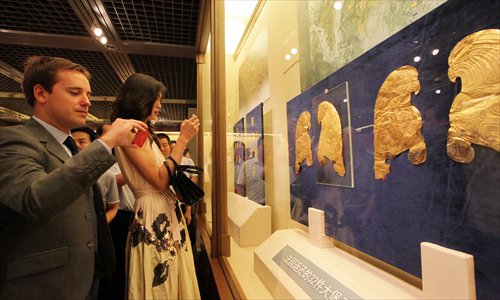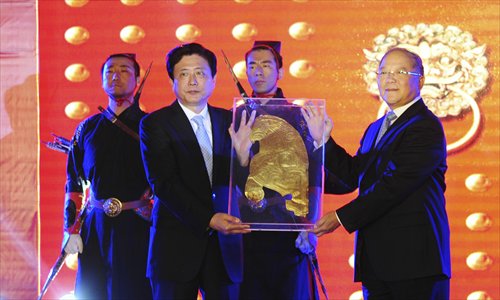France returning treasure to China sets precedent for further restitutions
The return to China of 32 gold ornaments, dating back to nearly 3,000 years ago, from French collectors this July marks the first time that the Chinese authorities have successfully recovered part of the country's looted heritage. While this will provide experience for future restitutions, it has been controversial in France as people debate whether this was legal according to French law. Legal and diplomatic barriers still cast doubt on the likelihood of other restitutions.

Visitors take photographs of the hawk-shaped gold ornaments on display at the Gansu Provincial Museum on July 20. Photo: CFP
After years of investigations and negotiations, after the combined efforts of diplomats, museums and private collectors, 32 ancient gold foils, dating back thousands of years, were returned to China this July.
They were looted from an ancient tomb in Gansu Province and sold to a French collector over two decades ago. They are currently being exhibited at the Gansu Provincial Museum.
Experts believe that this successful restitution, in which the Chinese authorities took the initiative to recover a piece of the country's lost heritage, could open the gate for more artifacts coming back to China in future.
"This will provide experience when we recover other heritage items in the future," Duan Yong, secretary of the Museum and Social Heritage office at the State Administration of Cultural Heritage, told the People's Daily.
The restitution, however, sparked controversy in France as to whether it was legally justified.

Top: Li Xiaojie (first from right), director of the State Administration of Cultural Heritage, hands an ornament to Liu Weiping, governor of Gansu Province. Photo: CFP
Decade-long campaign
The story of the stolen treasure can be traced to two decades ago, when Christian Deydier, a famous French collector, bought several gold ornaments from a Taiwanese antiques dealer in Hong Kong in 1993, according to the Chinese magazine Sanlian Life Week.
In 1994, he showed them to Han Wei, famous Chinese archeologist and former director of Shaanxi's Provincial Institute of Archeology, when Han visited Paris. Han, amazed by the distinct geometric design of the artifacts, tried to trace the origins of the ornaments after he returned to China, with the help of Deydier. Through research, he decided it was very likely that the items belonged to a looted Eastern Zhou Dynasty (770-256 BC) tomb in Gansu. Han later published his findings in Chinese and French publications.
In 2000, Deydier received a phone call from the wife of the Taiwanese dealer, who sold him more gold ornaments resembling the items her now deceased husband had previously sold to him, including four hawk-shaped gold foils. Deydier bought the pieces.
In the same year, France's then president Jacques Chirac, an admirer of Chinese art, after learning of the existence of the ornaments, persuaded his billionaire friend Francois Pinault, founder of the French luxury group Kering which owns brands such as Gucci, to buy the four hawk-shaped ornaments from Deydier and donate them to a public museum.
After Pinault donated his pieces, Deydier followed suit with his remaining 28 relics from the set. This is how the items ended up in the Guimet Museum, a Parisian museum that specializes in Asian art.
In 2005, China's State Administration of Cultural Heritage launched an investigation into Chinese antiques that were illicitly taken overseas, and completed a report on the relics that were believed to be stolen from Dabaozi in Gansu.
In November that year, Gansu's Bureau of Cultural Heritage selected Bernard Gomez, a French expert on Chinese antiques, to be its representative to help search for stolen Chinese relics around the globe. In an authorization letter, the bureau compiled evidence to prove the gold ornaments exhibited in the Guimet Museum were the relics that were looted between 1992 and 1993 from a tomb in Li county, Gansu, that dates back to the Eastern Zhou Dynasty.
"They were illegally taken to the antique market in Paris, and thus it's reasonable to return them to their origin in Gansu, China," the authorization letter says, "Given that, the Bureau of Cultural Heritage authorizes Bernard Gomez to demand on our behalf the return of these valuable relics with any possible legal measures."
Gomez filed a lawsuit against Deydier, the Guimet Museum and the French Ministry of Culture in 2006, accusing them of "concealment and laundering of artwork from international trafficking of goods and cultural objects." The court in France accepted the lawsuit and in October 2006, Deydier stood trial.
The court, however, denied there was enough consistent evidence to support the claim that these relics were stolen from China.
Four years later, in 2010, the State Administration of Cultural Heritage resumed its efforts to recover the ornaments. Duan, representing the Chinese government, wrote to the Guimet Museum in 2010, asking it to return the ornaments.
Through diplomatic connections, the two countries set up a panel of experts to collect evidence that the ornaments were looted from a Chinese archeological site.
In 2014, which marks the 50th anniversary of the establishment of diplomatic relations between France and China, the French government finally agreed that China's request for the restitution was justified.
Duan said that to facilitate the restitution, China ceased cooperation with the museum in question and discussed the matter with foreign representatives on multiple occasions.
"On the basis of scientific investigations and finding a complete chain of evidence, it's important to have long-term, friendly talks and negotiations … We used every possible means to make possible the return of the items," he said.
Legal conundrum
While the Chinese media lauded the return of the foils as a national victory and diplomatic success, controversy rose in France over whether the government violated national law in returning the objects to strengthen its ties with China.
According to French law, a public museum has no right to give away any part of its collection to a foreign nation. To smooth the way for the restitution, the French government asked the museum to reverse their donation and return the objects to its original private owners, so that they could return them to China on an individual basis.
According to AFP, Deydier was furious about the cancellation of his donation to the Guimet Museum and the decision of the French government, arguing that it did not go through a proper legal process.
"The Minister (of Culture of France) made a major error by ignorance, by making a cancellation of the donation. Only the National Assembly is empowered to do so," he told AFP.
"It's France's heritage which is suffering," he said.
When interviewed by Chinese magazine Sanlian Weekly, published last month, he said again that France set a dangerous precedent returning its public collection to its original country. "This way the collections of most Western museums could be returned to their home countries," he told the magazine.
Deydier is a generous collector and has donated around 70 objects to the Guimet Museum alone in the past two decades. However, frustrated by the restitution, he now wants the French government to reverse all the donations of Chinese objects that he has made to France's public museums.
The case of the gold ornaments and the reaction in France shows the challenges of recovering cultural artifacts through legal means. While many think international law should be used when recovering stolen ancient objects, experts say in reality, legal means are often the most difficult.
China became party to the 1970 UNESCO Convention, the first international treaty dedicated to the fight against the illicit trafficking of cultural property, in 1989. However, as the Convention is not retroactive, China is only able to seek the return of artifacts which were illegally exported after 1989 to another state party to the treaty.
The majority of Chinese artifacts overseas were looted before that, beginning in the Opium War during the late Qing Dynasty (1644-1911), when troops from an international coalition invaded and looted imperial gardens and royal palaces in North China, including the old Summer Palace.
The second wave of looting occurred in the late 19th century, when exploration teams from Europe and the US went to western China and took away objects from sparsely-populated but culturally rich areas, such as the caves of Dunhuang, Gansu. This was followed by the mass Japanese looting of relics during its invasion and occupation of China in the 1930s and 1940s.
According to a UNESCO report, 1.6 million historical objects from China are estimated to be sitting in 200 museums in 47 countries, and millions more are estimated to be in private hands.
Even if an item was illegally sent to another country after 1989, restitution is not supported by many individual countries which use a civil law system, which usually gives priority to the rights of the innocent purchaser of a stolen item.
The 1995 UNIDROIT Convention made it the responsibility of prospective buyers to exercise due diligence before making a purchase. China joined the convention in 1997, meaning only objects that were illicitly exported after 1997 are protected under the treaty.
Nationalism versus internationalism
The international community has long debated what to do about the ownership of cultural objects. One way of thinking, called cultural nationalism, sees such relics as part of a national cultural heritage and advocates their return to their country of origin, on the other hand cultural internationalists think of them as components of a common human culture.
"It's impossible for China to recover all its heritage - nor does China have the capability to do that. But China can try to have a special focus on some items that have spsecial value or importance," Peng Lei, research fellow at the China Cultural Heritage Protection Research Institute, told the Procuratorial Daily.
So far, due to the complications of the law, donations and commercial purchases are still the two major ways that China has been recovering its lost heritage, according to Huo Zhengxin, vice director of the school of international law at the China University of Political Science and Law.
A recent case that illustrates this is China's recovery of a 1,000-year-old mummified monk encased in a Buddha statue, which was stolen from a temple in Fujian Province and later bought by a Dutch collector.
While the provincial and national authorities tried to recover the statue by researching and proving its origins and sending representatives to talk to its owner, the Dutch collector finally agreed to return it only after he made an agreement with an unidentified foundation, which offered him some compensation for his investment.
Newspaper headline: Heirloom homecoming